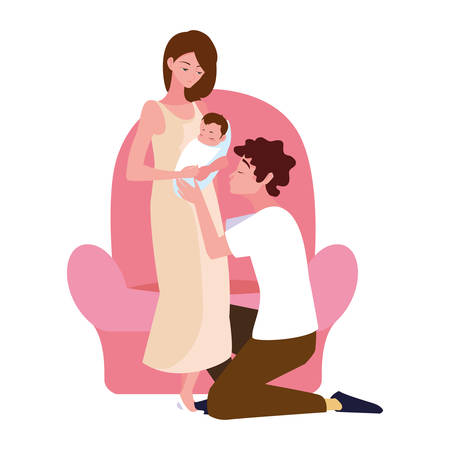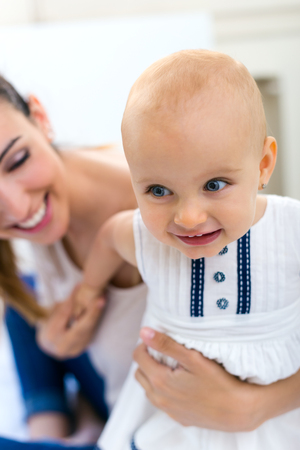1. Not Cleaning the Umbilical Cord Stump Properly
Many parents either over-clean or neglect the umbilical cord stump. It’s important to find a balance to ensure proper healing and prevent infections. The umbilical cord stump will naturally dry up and fall off within one to three weeks, but in the meantime, proper care is essential.
How to Care for the Umbilical Cord Stump
- Keep it dry: Avoid covering it with tight clothing or diapers. Fold the diaper down to allow air circulation.
- Avoid unnecessary cleaning: Unless there is visible dirt or residue, there’s no need to clean it frequently.
- Use gentle cleaning methods: If needed, use a cotton swab dipped in warm water to gently wipe around the base.
- No alcohol or harsh chemicals: In the past, rubbing alcohol was recommended, but now pediatricians suggest letting it dry naturally.
- Monitor for signs of infection: Redness, swelling, foul odor, or pus could indicate an infection. Contact your pediatrician if you notice these symptoms.
What to Expect as It Heals
| Stage | Description |
|---|---|
| Dried appearance | The stump will turn from yellowish-green to brown or black as it dries out. |
| Naturally falling off | The stump will detach on its own—never pull it off forcefully. |
| Slight bleeding | A small amount of bleeding is normal when it falls off, but excessive bleeding needs medical attention. |
When to Call the Doctor
If you notice any unusual symptoms such as persistent redness, warmth around the area, pus, a bad smell, or fever in your baby, consult your pediatrician immediately. Proper umbilical cord care ensures a smooth healing process and keeps your newborn safe from infections.
Skipping Regular Handwashing
Newborns have delicate immune systems, making them more vulnerable to germs and infections. Parents, caregivers, and anyone handling the baby should always wash their hands before touching the infant. Neglecting this simple step can lead to unnecessary illnesses.
Why Handwashing Is Important
Germs can easily spread through touch, especially from surfaces like doorknobs, phones, or even other people. Washing hands helps remove bacteria and viruses that could be harmful to a newborn.
When Should You Wash Your Hands?
| Situation | Reason |
|---|---|
| Before holding or feeding the baby | Prevents transferring germs from your hands to the babys mouth or skin |
| After changing diapers | Avoids spreading bacteria from waste materials |
| After coughing, sneezing, or blowing your nose | Keeps respiratory viruses away from the baby |
| After touching pets or unclean surfaces | Reduces risk of passing pet dander and dirt to the newborn |
| Before preparing baby bottles or food | Makes sure the babys food remains germ-free |
The Right Way to Wash Your Hands
A quick rinse isnt enough—proper handwashing takes at least 20 seconds with soap and water. Be sure to scrub between fingers, under nails, and around wrists. If soap and water aren’t available, use an alcohol-based hand sanitizer with at least 60% alcohol.

3. Bathing Too Frequently or Not Enough
Newborns don’t need daily baths—two to three times a week is sufficient. Overbathing can strip away the natural oils that protect their delicate skin, leading to dryness and irritation. On the other hand, not bathing your baby often enough can result in sweat, milk residue, and diaper area buildup, which may cause rashes or discomfort.
How Often Should You Bathe Your Newborn?
To keep your baby clean without over-drying their skin, follow these general guidelines:
| Age | Recommended Bathing Frequency |
|---|---|
| 0-4 weeks (before umbilical cord falls off) | Sponge baths as needed |
| 1-3 months | 2-3 times per week |
| 3+ months | 2-3 times per week or as needed |
Tips for Safe and Gentle Bathing
- Sponge Baths First: Until the umbilical cord stump falls off, stick to sponge baths using a warm washcloth.
- Lukewarm Water: Keep the water temperature around 98-100°F (37-38°C) to prevent discomfort.
- Mild Baby Soap: Use fragrance-free, gentle baby soap sparingly to avoid drying out the skin.
- Padded Surface: Ensure your baby is on a safe, non-slip surface when bathing.
- No Long Soaks: Keep bath time under 10 minutes to prevent skin from drying out.
- Moisurize After Bath: Apply a mild baby lotion to lock in moisture and protect delicate skin.
Sponge Baths vs. Tub Baths
If youre unsure whether to give your newborn a sponge bath or a tub bath, here’s a simple comparison:
| Sponge Bath | Tub Bath | |
|---|---|---|
| When to Use | If the umbilical cord is still attached or if the baby has sensitive skin issues. | If the umbilical cord has fallen off and your baby enjoys being in water. |
| Main Benefit | Avoids excessive exposure to water while keeping baby clean. | Cleanses more thoroughly and can be soothing for babies who enjoy baths. |
| Caution | Avoid making the cloth too wet; just dampen it slightly. | Never leave your baby unattended in the bath, even for a second. |
A balanced approach to bathing ensures your newborn stays fresh and comfortable without compromising their delicate skin. Stick with gentle cleaning methods, use the right products, and adjust based on your babys needs!
4. Using Harsh Products on Baby’s Skin
A newborn’s skin is delicate and sensitive, making it important to choose the right products. Many parents unknowingly use scented soaps, lotions, or wipes that contain chemicals, which can cause irritation, dryness, or even allergic reactions.
Why Harsh Products Can Be Harmful
Babies have thinner skin than adults, which means they absorb substances more easily. Harsh ingredients like artificial fragrances, dyes, and alcohol can strip away natural oils, leading to discomfort and rashes.
Best Practices for Choosing Baby-Safe Products
To protect your baby’s delicate skin, opt for gentle and natural products. Look for labels that indicate they are hypoallergenic and fragrance-free.
| Product Type | Avoid | Recommended |
|---|---|---|
| Soap | Scented, antibacterial soaps with harsh chemicals | Mild, fragrance-free baby soap |
| Lotion | Lotions with artificial fragrances and dyes | Hypoallergenic, fragrance-free baby lotion |
| Wipes | Wipes with alcohol or strong scents | Water-based, unscented baby wipes |
| Laundry Detergent | Regular detergent with strong perfumes and dyes | Baby-safe, dye-free detergent |
Tips for Keeping Baby’s Skin Healthy
- Bathe sparingly: Newborns don’t need daily baths—two to three times a week is enough.
- Avoid hot water: Use lukewarm water to prevent drying out their skin.
- PAT dry instead of rubbing: Gently pat their skin dry to avoid irritation.
- Moisutrize when needed: If your baby has dry skin, apply a small amount of fragrance-free lotion.
- Dress in soft fabrics: Use breathable cotton clothing washed with gentle detergent.
Selecting the right products and following these simple steps will help keep your newborn’s skin soft, healthy, and free from irritation.
5. Not Changing Diapers Often Enough
Leaving a wet or soiled diaper on for too long can cause diaper rash, discomfort, and even infections. Newborns have sensitive skin, and prolonged exposure to moisture and bacteria can quickly lead to irritation.
How Often Should You Change Your Baby’s Diaper?
Newborns go through many diapers each day. To keep your baby comfortable and rash-free, follow these general guidelines:
| Babys Age | Diaper Changes Per Day |
|---|---|
| Newborn (0-1 month) | 10-12 times |
| 1-6 months | 8-10 times |
| 6+ months | 6-8 times |
Signs It’s Time for a Diaper Change
- A noticeable wet or soiled diaper
- Your baby seems fussy or uncomfortable
- The diaper feels heavy when touched
- You notice a strong smell of urine or stool
Tips to Avoid Diaper Rash
- Check frequently: Always check your babys diaper every couple of hours.
- Cleansing properly: Use gentle wipes or warm water with a soft cloth.
- Airing out: Give your baby some diaper-free time to let their skin breathe.
- Selecting the right products: Use fragrance-free wipes and apply diaper cream as needed.
A clean and dry diaper keeps your baby happy and helps prevent skin irritation. Make it a habit to change diapers promptly to ensure your little one stays comfortable throughout the day!
6. Overlooking Baby’s Nails
Newborns’ nails grow quickly and can be surprisingly sharp. Since babies have little control over their movements, they can accidentally scratch their face, arms, or even you! Keeping their nails trimmed is an important part of newborn hygiene that many parents overlook.
How to Safely Trim Your Baby’s Nails
Trimming a newborn’s tiny nails may seem intimidating, but with the right tools and techniques, it can be done safely and easily.
| Method | How to Do It |
|---|---|
| Baby Nail Clippers | Use clippers designed for infants with rounded edges. Trim when your baby is sleeping or calm to avoid sudden movements. |
| Nail File | A gentle nail file can smooth out sharp edges without the risk of cutting too short. |
| Bite or Peel (Not Recommended) | Some parents try to bite or peel their babys nails, but this can lead to jagged edges or infection. |
Tips for Stress-Free Nail Trimming
- Choose the Right Time: Trim your baby’s nails after a bath when they are softer and easier to manage.
- Create a Calm Environment: A relaxed baby makes trimming much easier—try feeding them beforehand.
- Use Good Lighting: Proper lighting helps you see clearly and avoid accidental nicks.
- Smooth Any Rough Edges: Even after trimming, gently filing the edges can prevent accidental scratches.


